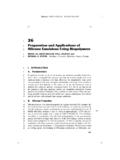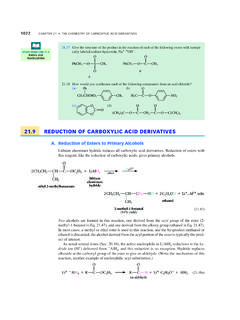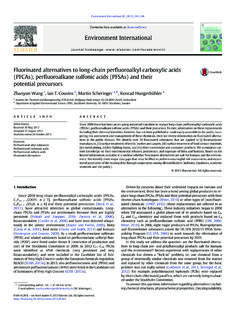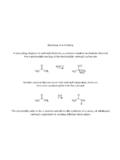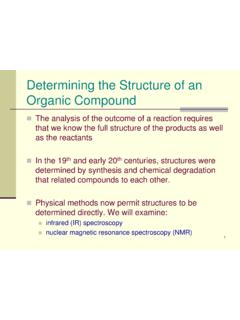Transcription of INCI - Nomenclature Conventions
1 inci - Nomenclature Conventions European Commission Enterprise and Industry Directorate General Consumer goods - Cosmetics 24/02/06 The Conventions used for establishing inci names are as follows: 1. In order to facilitate use and clarity, inci names have been designed to require a minimum of punctuation and capitalisation. 2. Wherever new Nomenclature has been adopted, every effort has been made to use the shortest name consistent with these rules. 3. Simple chemical names are used wherever possible. 4. Recognised chemical abbreviations are used where applicable. A list of the abbreviations used in the Inventory may be found under the section Abbreviations . 5. Traditional stems are retained as combining forms when consistent with other systems (see rule 17).
2 6. Abbreviations are utilised for simplifying the Nomenclature of families of complex ingredients when applicable (see abbreviation list under the section Abbreviations ). 7. Compounds that are related or are similar to materials described in recognised sources are named, whenever possible, by analogy to the listed names. 8. Singly substituted derivatives do not usually include the prefix mono . This term is used only when required to prevent ambiguity. The absence of a suitable prefix implies 'mono , Glyceryl stearate. 9. The term Glyceride has been utilized to describe a monoglyceride. Mixtures of mono-, di- and triglycerides are referred to as Glycerides . Triglycerides are assigned specific Nomenclature , Tristearin.
3 10 Multiple substitution is routinely described with the appropriate prefix such as di- , tri- or tetra- , Glyceryl distearate. 11. Names of ingredients, other than colours, that contain terminal numbers are generally hyphenated. derivatives of hyphenated materials retain the original hyphen, Laureth-3, Laureth-3 phosphate. 12. Hydration states are not usually expressed. 13. Straight-chain alkyl groups are described by their common stem names (see rule 17). 14. Materials containing mixtures of even-carbon chain length fractions are named by the appropriate commonly used fatty stem term, Cetearyl alcohol (C16 and C18). Materials containing mixtures of even- and odd-carbon chain length fractions are designated by alternative Nomenclature , C12-15 alcohols (C12, C13, C14 and C15).
4 15. Branched-chain alkyl groups are usually described by the prefix iso followed by the common stem name for the comparable straight-chain group ( Isostearyl alcohol, Isocetyl alcohol) see also rule 17. The major exception to this rule is the Nomenclature for the 2-alkyl of Guerbet alcohols. These are named by standard chemical rules ( Ethylhexanol, Octydodecanol, Decyltetradecanol). derivatives are named accordingly ( Ethylhexyl myristate, Cetyl ethylhexanoate, Diethylhexylamine, Triethylhexanoin, Butyloctanoic acid ). 16. The following table has been included to clarify the Nomenclature for derivatives of caproic, caprylic and capric acids. Chain length Stem nameAcidEsterC6 Capro Caproic Caproate C8 Capryl Caprylic Caprylate C10 Capr Capric Caprate Chain lengthAcylAlkylAmphoC6 Caprooyl Caproyl Caproo C8 Capryloyl Caprylyl Caprylo C10 Caproyl
5 Capryl Capro 17. The following table describes the Nomenclature applied to straight-chain acids and alcohols. Branched-chain acids and alcohols utilize the names listed in this table preceded by the term iso ( Isostearic acid ). Guerbet alcohols, however, are designated by specific names ( Octyldodecanol). (See also rule 15). Saturated: AcidAlcoholC6 Caproic Hexyl C7 Heptanoic Heptyl C8 Caprylic Caprylyl C9 Pelargonic Nonyl C10 Capric Decyl C11 Undecanoic Undecyl
6 C12 Lauric Lauryl C13 Tridecanoic Tridecyl C14 Myristic Myristil C15 Pentadecanoic Pentadecyl C16 Palmitic Cetyl C17 Margaric Heptadecyl C18 Stearic Stearyl C20 Arachidic Arachidyl C22 Behenic Behenyl Unsaturated.
7 C11 Undecylenic Undecylenyl C16 Palmitoleic Palmitoeyl C18 Oleic Oleyl C18 Linoleic Linoleyl C18 Linolenic Linolenyl C20 Arachidonic Arachidonyl C22 Cetoleic Cetoleyl C22 Erucic Erucyl 18.
8 The Nomenclature for ingredients consisting of mixtures of similar materials ( fatty acids, fatty alcohols) is determined on the basis of the chemical identity of the raw material as purchased. Mixtures that reflect the original distribution of components due to their natural source ( coconut) are named utilizing the source stem ( coconut alcohol). If the original natural distribution has been significantly cut or enriched, the mixture is named on the basis of the predominant component. 19. Names of lanolin derivatives usually contain the stem lan , Laneth-60. 20. Because of the existing widespread use of these denominations, alkanolamides are named from the parent alkyl amide and the appropriate abbreviation for the amine used, Cocamide MEA.
9 21. The dimethyl term is omitted and is assumed in all alkyl dimethyl amine oxide names ( Stearamine oxide). Tertiary amine oxides with different substituent groups are named completely ( Dihydroxyethyl stearamine oxide). 22. Quaternary, ammonium salts usually have the suffix -ium in the stem of the cation. The term monium describes a monomethyl-substituted quaternary nitrogen; dimonium describes a dimethyl-subsituted quaternary nitrogen; trimonium describes a trimethyl-substituted quaternary nitrogen. 23. The terms quaternium/polyquaternium are used to describe complex quaternary ammonium salts that do not have a common name or that cannot be named by analogy to established names ( Quaternium-82, Polyquaternium-20).
10 24. The term ampho has been used as a combining term in the Nomenclature for amphoteric surfactants derived from imidazoline intermediates. In naming these compounds, this stem is combined with the appropriate stem names for the subsituent groupings ( Sodium Cocoamphoacetate). 25. Common fatty stem terms are used to designate the alkyl portion of alkyl imidazoline compounds ( Lauryl Hydroxyethyl Imidazoline) even though one carbon atom of the fatty radical becomes a member of the heterocyclic ring during the materials manufacture. 26. Biological materials are named by specific terms ( Hyaluronic acid , Hydrogenated Menhaden Oil) when the material has been isolated, purified and chemically characterized. Alternative Nomenclature for biologicals is utilized to name materials in accordance with the extent of their processing.


